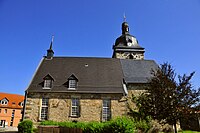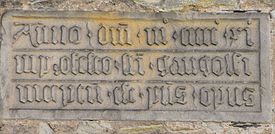Hohenkirchen (Georgenthal)
|
Hohenkirchen
Rural community Georgenthal
|
||
|---|---|---|
| Coordinates: 50 ° 50 ′ 55 " N , 10 ° 42 ′ 4" E | ||
| Height : | 350 m above sea level NHN | |
| Area : | 6.8 km² | |
| Residents : | 730 (Dec. 31, 2019) | |
| Population density : | 107 inhabitants / km² | |
| Incorporation : | December 31, 2019 | |
| Postal code : | 99887 | |
| Area code : | 036253 | |
|
Location of Hohenkirchen in Thuringia |
||
Hohenkirchen is a district of the rural community Georgenthal in the Thuringian district of Gotha .
geography
Hohenkirchen is located on the northern edge of the Thuringian Forest in the vicinity of Herrenhof and Georgenthal (1.5 and 4 km away, respectively), Ohrdruf (3.6 km) and Petriroda (2.3 km). Due to the nearby federal road 247 , the place is connected to Gotha and the federal highway 4 as well as to the larger economic regions in the nearby Thuringian Forest.
history
The village of Hohenkirchen was first mentioned in a document on June 14, 1168.
The location of Hohenkirchen on the northern edge of the Thuringian Forest , with fast-flowing brooks and near extensive forests that are fully owned by the Georgenthal Monastery, may be a main reason for choosing this location to build one of the first Saigerhütten in Thuringia in the late 15th century have been the Fuggers. The task of the Saigerhütten was the best possible separation of copper and silver ; the process also required lead , which the Fuggers could obtain from the Gosla mining area . A suitable smelter location closer to the Harz Mountains was not found, and the proximity to the competing Mansfeld copper mining area may have been avoided. In the period 1510 to 1513 was in Hohenkirchen 24,489 quintals of raw copper gesaigert , there were 24,191 quintals produced Garkupfer. The amounts of charcoal required for this were considerable. The craftsmen in the neighboring cities of Gotha , Erfurt , Saalfeld and Arnstadt, who were exposed to the shortage of charcoal, complained about the rapidly rising costs for charcoal. Profits were apparently only made by the smelter operators, who had most of the raw copper transported by land to Thuringia from their own copper smelters in the mining region of Banská Bystrica, which at that time belonged to the Kingdom of Hungary . The Saiger smelting company, which was initially built up by patrician families from Nuremberg and Augsburg , was soon imitated in neighboring Thuringian regions with the financial participation of the sovereigns. However, the profit made there was already significantly lower, as the silver content in the Thuringian raw copper was lower.
After the dissolution of the Georgenthal monastery, the place belonged to the Georgenthal office from 1531 , which had belonged to the Duchy of Saxony-Gotha since 1640 .
Since February 6, 1992, the Hohenkirchen community was a member of the Apfelstädtaue administrative community based in Georgenthal. With the dissolution of this on December 31, 2019, Hohenkirchen merged with other communities to form the rural community of Georgenthal.
Population development
Development of the population (December 31) :
|
|
|
|
|
politics
Former councilor
In the municipal council elections in 2014, the CDU won six seats, the FDP two. In 2017, both parties each had one seat less, but there were now two non-party municipal councils.
Former mayor
The last mayor of the Hohenkirchen community was Jürgen Beese (CDU).
coat of arms
| Blazon : "In red with a black latticed left silver upper corner, a golden knight on a golden-bridled silver steed striding to the right with a silver shield with a black groin cross, in his right hand holding a black lance with a silver tip." | |
Attractions
The Church of St. Gangolf was built in 1510/1511 as a hall church with a retracted choir . This construction date and the financing of the church building is evidently directly related to the Saigerhütte built on the outskirts. After the introduction of the Reformation in 1532, the church tower made of demolished stones from the Georgenthal monastery was added between 1576 and 1579. The building of the tower and the construction of a girls' school were initiated by the pastor of the Hohenkirchen / Herrenhof / Petriroda parish, Theodor Evander . The congregation also owed the organ, bought in 1609, to the financial support of the pastor. Today's organ comes from the Knauf workshop from 1819, where Rudolf Böhm from Gotha made the last changes around 1960.
In the 17th and 18th centuries, the baroque tower dome and the baroque pulpit altar with rich sculptural decoration from 1776 and the two-storey gallery were created during renovations . The tower dome and the tower clock from 1844 were destroyed in the Second World War . On the occasion of the 500th anniversary of the church, a newly procured clockwork was started on August 28, 2011.
Personalities
Sons and daughters of the place
- Georg Böhm (1661–1733), organist and composer of the Baroque
Personalities who have worked in this city
- Jakob Fugger founded a Saigerhütte in Hohenkirchen after 1495 .
literature
- Peter Lange: Saigerhütten in Thuringia. In: Saigerhütte Hohenkirchen In: Copper silver steel - Contributions to the history of metallurgy. Published by the museums of the city of Olbernhau, Olbernhau 1988, pp. 26–28
Web links
Individual evidence
- ↑ Wolfgang Kahl. First mention of Thuringian cities and villages. A manual. Rockstuhl Verlag, Bad Langensalza, 2010, ISBN 978-3-86777-202-0 , p. 126
- ^ W. Fischer: Mining and metallurgy of Thuringia on the eve of the early bourgeois revolution . In: Mühlhausen museums (ed.): Mühlhäuser contributions . No. 9 . Mühlhausen / Thuringia 1986, p. 32-42 .
- ↑ Gerald Patzelt: Some thoughts and additions to a work on mining and metallurgy in Thuringia on the eve of the early bourgeois revolution . In: Mühlhausen museums (ed.): Mühlhäuser contributions . No. 11 . Mühlhausen / Thuringia 1988, p. 18-25 .
- ↑ Thuringian Law and Ordinance Gazette No. 11/2019 of October 18, 2019, p. 385 ff. , Accessed on December 30, 2019
- ↑ Thüringer Allgemeine (local page Gotha) from May 25, 2011




